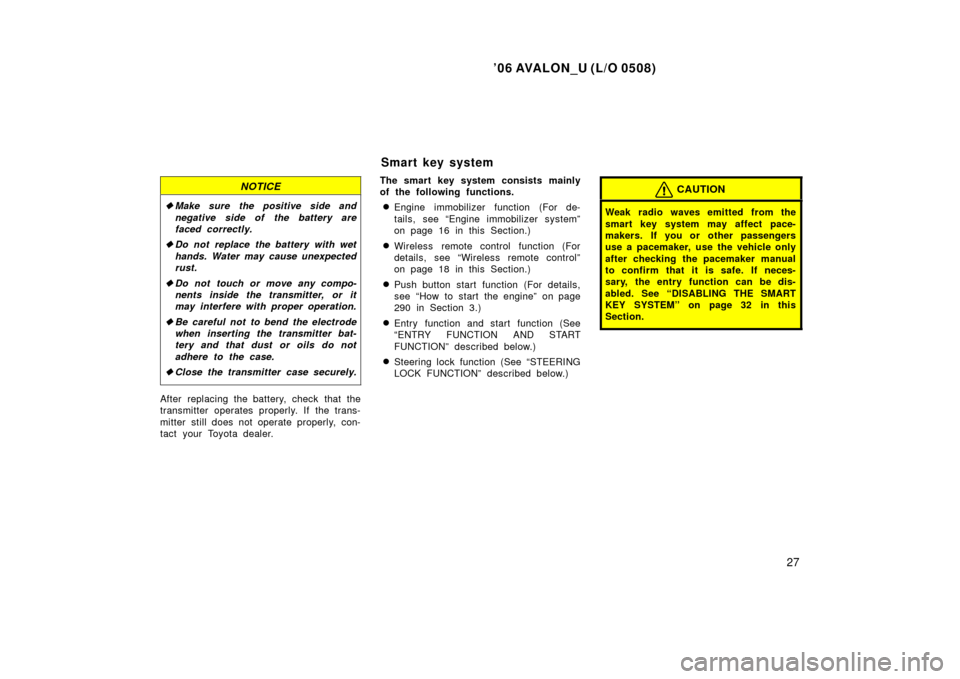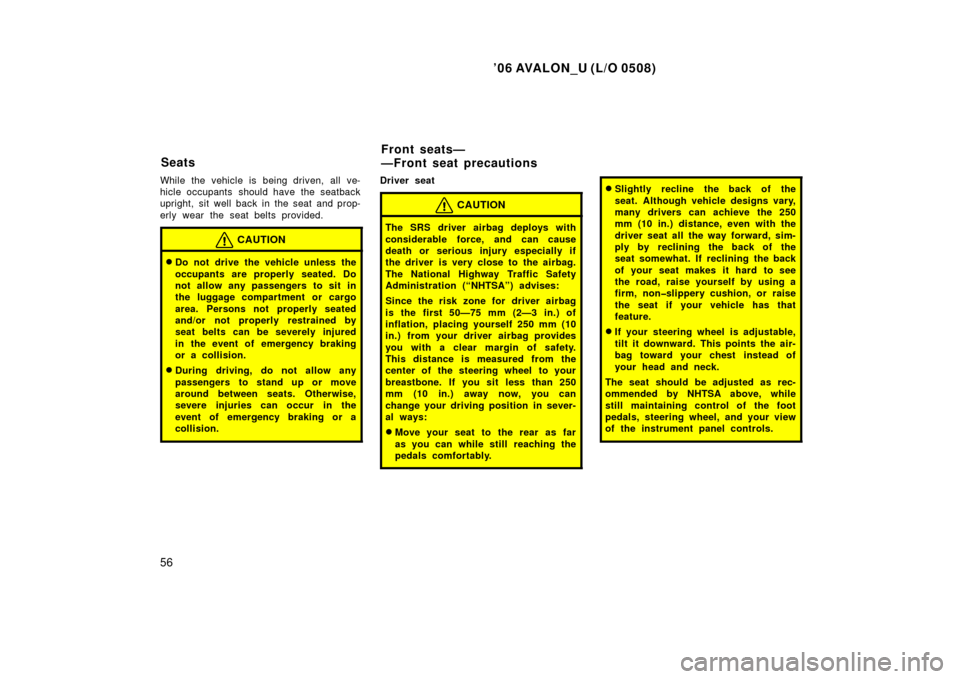Page 5 of 398

’06 AVALON_U (L/O 0508)
v
�SRS airbag system diagnostic data
If your vehicle is equipped with a vehicle stability control
(VSC) system, its Electronic Control Unit (ECU) may con-
tain another EDR. There are a variety of driving situations
which include activating the VSC under which the VSC
EDR will record certain information. The VSC EDR may
record some or all of the following information:
� Behavior of the vehicle
� Steering wheel angle
� Vehicle speed
� To what extent the accelerator pedal was depressed
� To what extent the brake pedal was applied
� To what extent the ECU controlled the condition of
the 4 wheels
� Vehicle stability control system di agnostic data
The information above is intended to be used for the
purpose of improving vehicle safety performance. Unlike
general data recorders, the EDR does not record sound
data such as conversation between passengers.Toyota will not disclose the data recorded in an EDR to a
third party except when:
� An agreement from the vehicle’s owner (or the leas-
ing company for a leased vehicle) is obtained
� Officially requested by the police or other authorities
� Used as a defense for Toyota in a law suit
� Ordered by the court
However, if necessary Toyota will:
� Use the data for research on Toyota vehicle safety
performance
� Disclose the data to a third party for research pur-
poses without disclosing details of the vehicle owner,
and only when it is deemed necessary
� Disclose summarized data cleared of vehicle identifi-
cation information to a non −Toyota organization for
research purposes
Page 8 of 398

’06 AVALON_U (L/O 0508)
viii
Tires and loading on yourTo y o t a
Underinflated or overinflated tire pressure and the
excess load may result in the deterioration of
steering ability and braking ability, leading to an
accident. Check the tire inflation pressure periodi-
cally and be sure to keep the load limits given in
this Owner ’s Manual. For details about tire inflation
pressure and load limits, see pages 283 and 355.
Scrapping of your Toyota
The SRS airbag and seat belt pretensioner devices in your
Toyota contain explosive chemicals. If the vehicle is
scrapped with the airbags and pretensioners left as they
are, this may cause an accident such as fire. Be sure to
have the systems of the SRS airbag and seat belt preten-
sioner removed and disposed of by the qualified service
shop or by your Toyota dealer before you dispose of your
vehicle.
Leak detection pump
This pump performs fuel evaporation leakage check. This
check is done approximately five hours after the engine is
turned off. So you may hear sound coming from under-
neath the luggage compartment for several minutes. It
does not indicate a malfunction.
Page 11 of 398
’06 AVALON_U (L/O 0508)
3
1. Instrument panel light control knob
2. Headlight, turn signal and front foglight switches
3. Audio remote control switches
4. Speech command switch (See the separate “Navigation System Owner ’s
Manual.”)
5. Climate remote control switches
6. Wiper and washer switches
7. Rear window and outside rear view mirror defogger switch
8. Emergency flasher switch
9. Audio system
10. Air conditioning controls 11. Cigarette lighter and ashtray, auxiliary box, cassette player or navigation
system controller (For the navigation
system, see the separate “Navigation
System Owner ’s Manual.”)
12. Ignition switch
13. Cruise control switch
14. Tilt steering lock release lever
15. Telescopic steering lock release lever
�
View B (with key cylinder�type ignition switch)
Page 13 of 398
’06 AVALON_U (L/O 0508)
5
1. Instrument panel light control knob
2. Headlight, turn signal and front foglight switches
3. Audio remote control switches
4. Speech command switch (See the separate “Navigation System Owner ’s
Manual.”)
5. Climate remote control switches
6. Wiper and washer switches
7. Rear window and outside rear view mirror defogger switch
8. Emergency flasher switch
9. Audio system
10. Air conditioning controls 11. Cigarette lighter and ashtray, auxiliary box, cassette player or navigation
system controller (For the navigation
system, see the separate “Navigation
System Owner ’s Manual.”)
12. Ignition switch (engine switch)
13. Cruise control switch
14. Distance switch
15. Tilt steering lock release lever
�
View B (with smart key system)
Page 14 of 398
’06 AVALON_U (L/O 0508)
6
16. Telescopic steering lock release lever
17. Glass breakage sensor
18. Rear electric sunshade switch
19. Trunk opener switch
20. Fuel filler door opener switch
21. Power rear view mirror control switches
Page 35 of 398

’06 AVALON_U (L/O 0508)
27
NOTICE
�Make sure the positive side and
negative side of the battery are
faced correctly.
� Do not replace the battery with wet
hands. Water may cause unexpected
rust.
� Do not touch or move any compo-
nents inside the transmitter, or it
may interfere with proper operation.
� Be careful not to bend the electrode
when inserting the transmitter bat-
tery and that dust or oils do not
adhere to the case.
� Close the transmitter case securely.
After replacing the battery, check that the
transmitter operates properly. If the trans-
mitter still does not operate properly, con-
tact your Toyota dealer. The smart key system consists mainly
of the following functions.
�Engine immobilizer function (For de-
tails, see “Engine immobilizer system”
on page 16 in this Section.)
�Wireless remote control function (For
details, see “Wireless remote control”
on page 18 in this Section.)
�Push button start function (For details,
see “How to start the engine” on page
290 in Section 3.)
�Entry function and start function (See
“ENTRY FUNCTION AND START
FUNCTION” described below.)
�Steering lock function (See “STEERING
LOCK FUNCTION” described below.)
CAUTION
Weak radio waves emitted from the
smart key system may affect pace-
makers. If you or other passengers
use a pacemaker, use the vehicle only
after checking the pacemaker manual
to confirm that it is safe. If neces-
sary, the entry function can be dis-
abled. See “DISABLING THE SMART
KEY SYSTEM” on page 32 in this
Section.
Smart key system
Page 36 of 398

’06 AVALON_U (L/O 0508)
28
Entry function
Start function
ENTRY FUNCTION AND START
FUNCTION
By carrying the key, you can lock and
unlock the doors and start the engine.
Entry function—You can lock and unlock
the doors and open the trunk without in-
serting the key in the keyhole. For further
information, see “Side doors” on page 33
in this Section.
Start function— You can shift the power
supply mode and start the engine when
the electronic key is in the vehicle. For
further information, see “Ignition switch”
on page 159 in Section 1 −7 and “How to
start the engine ”on page 290 in Section
3. STEERING LOCK FUNCTION
When the driver ’s door is opened after
turning off the engine, the steering wheel
will lock.
The steering lock is automatically un-
locked when the “ENGINE START STOP”
switch (engine switch) is pressed. If the
indicator light on the “ENGINE START
STOP” switch flashes green, this indicates
that the steering wheel remains locked. If
the amber indicator light flashes, this indi-
cates that the steering lock is malfunction-
ing. For details, see “How to start the
engine” on page 290 and “Driving and
parking using smart key system” on page
293 in Section 3.
Page 64 of 398

’06 AVALON_U (L/O 0508)
56
While the vehicle is being driven, all ve-
hicle occupants should have the seatback
upright, sit well back in the seat and prop-
erly wear the seat belts provided.
CAUTION
�Do not drive the vehicle unless the
occupants are properly seated. Do
not allow any passengers to sit in
the luggage compartment or cargo
area. Persons not properly seated
and/or not properly restrained by
seat belts can be severely injured
in the event of emergency braking
or a collision.
�During driving, do not allow any
passengers to stand up or move
around between seats. Otherwise,
severe injuries can occur in the
event of emergency braking or a
collision.
Driver seat
CAUTION
The SRS driver airbag deploys with
considerable force, and can cause
death or serious injury especially if
the driver is very close to the airbag.
The National Highway Traffic Safety
Administration (“NHTSA”) advises:
Since the risk zone for driver airbag
is the first 50—75 mm (2—3 in.) of
inflation, placing yourself 250 mm (10
in.) from your driver airbag provides
you with a clear margin of safety.
This distance is measured from the
center of the steering wheel to your
breastbone. If you sit less than 250
mm (10 in.) away now, you can
change your driving position in sever-
al ways:
�Move your seat to the rear as far
as you can while still reaching the
pedals comfortably.
�Slightly recline the back of the
seat. Although vehicle designs vary,
many drivers can achieve the 250
mm (10 in.) distance, even with the
driver seat all the way forward, sim-
ply by reclining the back of the
seat somewhat. If reclining the back
of your seat makes it hard to see
the road, raise yourself by using a
firm, non�slippery cushion, or raise
the seat if your vehicle has that
feature.
�If your steering wheel is adjustable,
tilt it downward. This points the air-
bag toward your chest instead of
your head and neck.
The seat should be adjusted as rec-
ommended by NHTSA above, while
still maintaining control of the foot
pedals, steering wheel, and your view
of the instrument panel controls.
Seats Front seats—
—Front seat precautions